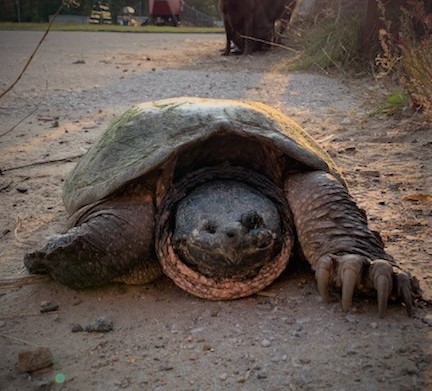Turtle species across Ontario are under threat, and it’s up to us to save them

Turtle species across Ontario are facing multiple threats to their survival. The two biggest threats are habitat loss and road mortality.
Many of their habitats, like marshes and swamps, have been altered by humans.
“So, in terms of what we’re seeing, of course, in especially in the last four years, is land conversion at a rate that has been unprecedented without sufficient planning tools,” said Leora Berman, Chief operating officer for the conservation organization The Land Between.
The Land Between is a bioregion extending from Ottawa Valley to Georgian Bay. It is home to 1/3 of Ontario’s turtle population and has seven to eight of Ontario’s turtle species. The Land Between is the last refuge for many turtles.
All eight turtle species in Ontario are classified as “species at risk.” Many are classified as endangered.
“Over 70% of wetlands in southern Ontario have been lost over the past century. This has removed the required habitat for many turtles and many other species of wildlife,” said David Seburn, Freshwater Turtle Specialist at the Canadian Wildlife Federation.
Wetlands are crucial for the survival of turtles and other important species.
Sadly, southern Ontario has the highest density of roads, which results in turtles getting run over by cars. Road mortality, along with habitat loss and other factors, contributes to the 50% decline in Ontario’s turtles.
Experts say if we lose another 20% of snapping turtles, they could be extinct in twenty years.

“During our surveys along major roads in eastern Ontario, we have found more than 1800 dead turtles on roads. That is a staggering level of roadkill,” said Seburn.
Many people fail to realize how important turtles are to the survival of our ecosystems. Turtles are a keystone species: meaning their role in the food web is crucial to the survival of many species and habitats. If we lose turtles, we could see a collapse in the ecosystem.
Remarkably, turtles help create new habitats. The older they get, the more vegetation they eat. This results in seeds in their stools, which helps sustain and recreate new habitats.
Turtles, like the snapping turtle, provide health benefits to humans. Think of young turtles like turkey vultures. While turkey vultures eat roadkill, snapping turtles eat dead carcasses at the bottom of lakes. By doing this, they remove bacteria harmful to us and the environment.
“They scour and clean up the bottoms of all our lakes and ponds and wetlands,” said Berman.
Many people wrongly believe relocating turtles offers a solution. Relocating turtles could result in their death. Turtles take snapshots of their territories in their mind. They stay around that same area all their life. Research shows they are likely to hibernate within 1 meter of where they hibernated the season before.
“You can’t just take a turtle from Southern or Lake Erie and bring it up here (Haliburton) and expect it to survive, because turtles only have high brain plasticity until the age of four,” said Berman.
Female turtles produce eggs, after reaching maturity, for their entire life. The death of a female adult turtle not only affects the already declining population but prevents hundreds of eggs from being laid.

Grace, a snapping turtle up in Haliburton, is thought to be roughly 125 years old. This makes her the oldest turtle found in that area. Berman is confident she is a female after doing some studies. Her survival is crucial to her species. Currently, the absence of standard zoning bylaws means Graces life is in danger.
“Turtles are slow to grow and can take 20 years or more to be mature. Turtle populations need high rates of adult survival to be stable,” said Seburn.
Since less than 1% of turtle eggs survive, it can take a turtle 60 years to replace itself in the population.

While all of Ontario’s turtles are under threat, Seburn says the most at-risk turtles are the Blanding’s turtle, Spiny Softshell, spotted turtle, and the wood turtle. The Blanding’s turtle is an endangered species globally and not just endangered in Canada.

“If wetland destruction continues in Ontario, there is the risk that we will lose some of the rarest species such as the Spotted Turtle,” said Seburn.
New developments are always in the works. Berman described the future for Ontario’s turtles as scary. Humans are always wanting more, and the results can be dangerous.
“It’s really quite scary because we don’t know how to self-regulate as human beings,” said Berman.
The survival of Ontario’s turtles lies in our hands. Turtles have been around for over 200 million years, so seeing them decline at the hands of humans is devastating and sad.
There is hope, however, if we act now.
Organizations like The Land Between have been working hard to protect turtles. Recently, they installed a Turtle Underpass System in Gooderham on County Road 3.
The Canadian Wildlife Federation has successfully installed turtle fences across Eastern Ontario.
“We have worked to get wildlife fencing installed at three of the worst roadkill hotspots for turtles in eastern Ontario.,” said Seburn.
Turtle fences are just one way of helping the species. Monitoring, surveying, summer camps, and community involvement are other important steps to help the survival of turtles.
If you ever find a turtle crossing the road and decide to help it, make sure you put your four ways on and watch for oncoming traffic. Always make sure you assist the turtle in the same direction they were already going. Directing a turtle in the opposite direction would do more harm than good.
There are many steps we can take to ensure the survival of turtles. The coming years will be crucial, but there is still hope for this ancient species.
Interactive by Piers Giffin
